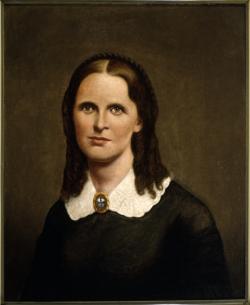 "I have known Minnesota from its infancy, and have loved it as a parent does a child, till my very being is entwined with her interests; and to me it is fit for paradise. Come to Minnesota, but bring with you the principles firm and unyielding"- Harriet Bishop, 1857.
"I have known Minnesota from its infancy, and have loved it as a parent does a child, till my very being is entwined with her interests; and to me it is fit for paradise. Come to Minnesota, but bring with you the principles firm and unyielding"- Harriet Bishop, 1857.
In 1847, Harriet Bishop traveled from Vermont to the small but growing city in the West, St. Paul. As part of a program led by educational reformer Catharine Beecher to send women teachers to help educate and civilize frontier children, Bishop was the first of her class to volunteer to go West. She came to the area that would soon become the Minnesota Territory to both educate the children of St. Paul and to exert her moral influence on the rough frontier town. Convinced that women were capable of teaching morality, Bishop became active in many moral issues such as temperance, educational reform, and women's suffrage. She is credited with starting the first public school in St. Paul and the first Sunday school, which led to the first Baptist church in the area.
The first school house, which she opened in a former blacksmith shop on 19 July 1847, was a "mud walled log hovel... covered with bark and chinked with mud" at what is now St. Peter Street and Kellogg Boulevard. Within less than a year, she organized the Saint Paul Circle of Industry to raise funds to build a new structure for the students. The new building also served as a church, meeting hall, and courtroom, and polling place. Of the seven students in her first class, only two were caucasian. She had to rely on a student who was fluent in French, Dakota, and English to translate for her classes (which she taught in English). Harriet wrote about her experiences, and also authored one of the first memoirs about the U.S.-Dakota War of 1862.
Harriet's words, in Floral Home, relay her assumption that the assimliation of American Indians was beneficial:
"Whatever the demand, it is satisfied, if possible, by those who "watch for their souls", and labor for the improvement and redemption of the race. Ah! what devote thanksgiving ascends to Heaven when one of these children of nature finds refuge beneath the cross, and grace commences its refining process upon the heart."
Harriet Bishop Biography. Minnesota Historical Society. Retrieved 2011-03-06.
Morton, Zylpha S.. Harriet Bishop, Frontier Teacher.
Sommerdorf, Norma. Harriet Bishop: A Doer and a Mover. MNHistory Magazine, Minnesota Historical Society.
Harriet, Bishop. Dakota War Whoop, Or, Indian Massacres and War in Minnesota, Of 1862-'3. W.M J. Moses' Press. Auburn, NY.1864.
Bishop, Harriet. Floral Home: or First Years of Minnesota. Sheldon, Blakeman,& Company. New York, 1857.
Kenney, Dave. Northern Lights: The Stories of Minnesota’s Past. St. Paul, MN: Minnesota Historical Society Press, 2003.




